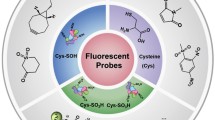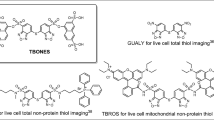Abstract
Cysteine (Cys) is an important endogenous amino acid and plays critical physiological roles in living systems. Herein, an endoplasmic reticulum (ER)-targeting fluorescent probe (FER-Cys) was designed and prepared for imaging of Cys in living cells. The probe FER-Cys consists of a fluorescein framework as the fluorescent platform, acrylate group as the response site for the selective recognition of Cys, and ER-specific p-toluenesulfonamide fragment. After the response of probe FER-Cys to Cys, a turn-on fluorescence signal at 546 nm could be detected obviously. The probe FER-Cys further shows desirable selectivity to Cys. Finally, the probe FER-Cys was proven to selectively detect Cys in live cells and successfully image the changes of Cys level in the cell models of H2O2-induced redox imbalance.









Similar content being viewed by others
References
Chiappetta G, Ndiaye S, Igbaria A, Kumar C, Vinh J, Toledano MB (2010) Proteome screens for Cys residues oxidation: the Redoxome. Method Enzymol 473:199–216
Lill R, Mühlenhoff U (2006) Iron-sulfur protein biogenesis in eukaryotes: components and mechanisms. Annu Rev Cell Dev Biol 22:457–486
Bulaj G, Kortemme T, Goldenberg DP (1998) Ionization-reactivity relationships for cysteine Thiols in polypeptides. Biochemistry 37:8965–8972
Heitmann P (1968) A model for sulfhydryl groups in proteins. Hydrophobic interactions of the Cystein side chain in micelles. Eur J Biochem 3:346–350
Nagano N, Ota M, Nishikawa K (1999) Strong hydrophobic nature of cysteine residues in proteins. FEBS Lett 458:69–71
Zanello P (2016) The competition between chemistry and biology in assembling iron–sulfur derivatives. Molecular structures and electrochemistry. Part III. {[Fe2S2](Cys)3(X)} (X = asp, Arg, his) and {[Fe2S2](Cys)2(his)2} proteins. Coordin Chem Rev 306:420–442
Morales-Martinez ME, Silva-García R, Soriano-Correa C, Giménez-Scherer JA, Rojas-Dotor S, Blanco-Favela F, Rico-Rosillo G (2008) The Cys-Asn-Ser carboxyl-terminal end group is the Pharmacophore of the amebic anti-inflammatory monocyte locomotion inhibitory factor (MLIF). Mol Biochem Parasit 158:46–51
Townsend D, Tew K, Tapiero H (2003) The importance of glutathione in human disease. Biomed Pharmacother 57:145–155
Lieberman MW, Wiseman AL, Shi Z, Carter B, Barrios R, Ou CN, Chévez-Barrios P, Wang Y, Habib GM, Goodman JC, Huang SL, Lebovitz RM, Matzuk MM (1996) Growth retardation and cysteine deficiency in gamma-Glutamyl Transpeptidase-deficient mice. Proc Natl Acad Sci U S A 93:7923–7926
Mizutani H, Nakanishi K, Yamamoto Y, Li N, Matsubara H, Mikami K, Okihara K, Kawauchi A, Bonavida B, Miki T (2005) Downregulation of Smac/DIABLO expression in renal cell carcinoma and its prognostic significance. J Clin Onco 23:448–454
Jones DP, Carlson JL, Mody VC, Cai J, Lynn MJ, Sternberg P (2000) Redox state of glutathione in human plasma. Free Radic Biol Med 28:625–635
Nguyen T, Chin WC, Verdugo P (1998) Role of Ca2+/K+ ion exchange in intracellular storage and release of Ca2+. Nature 395:908–912
Pollard TD, Earnshaw WC, Johnson GT (2017) (2012) cell biology, 3rd edn. Elsevier, Netherlands
Ozcan L, Tabas I (2012) Role of endoplasmic reticulum stress in metabolic disease and other disorders. Annu Rev Med 63:317–328
Katayama T, Imaizumi K, Sato N, Miyoshi K, Kudo T, Hitomi J, Morihara T, Yoneda T, Gomi F, Mori Y, Nakano Y, Takeda J, Tsuda T, Itoyama Y, Murayama O, Takashima A, George-Hyslop P, Takeda M, Tohyama M (1999) Presenilin-1 mutations downregulate the signalling pathway of the unfolded-protein response. Nat Cell Biol 1:79–485
Özcan U, Cao Q, Yilmaz E, Lee AH, Iwakoshi NN, Özdelen E, Tuncman G, Görgün C, Glimcher LH, Hotamisligil GS (2004) Endoplasmic reticulum stress links obesity, insulin action, and type 2 diabetes. Science 306:457–461
Meng Q, Jia H, Succar P, Zhao L, Zhang R, Duan C, Zhang Z (2015) A highly selective and sensitive ON-OFF-ON fluores cence chemosensor for cysteine detection in endoplasmic reticulum. Biosens Bioelectron 74:461–468
Zhang J, Weng Y, Liu X, Wang J, Zhang W, Kim SH, Zhang H, Li R, Kong Y, Chen X, Shui W, Wang N, Zhao C, Wu N, He Y, Nan G, Chen X, Wen S, Zhang H, Deng F, Wan L, Luu HH, Haydon RC, Shi LL, He TC, Shi Q (2013) Endoplasmic reticulum (ER) stress inducible factor cysteine-rich with EGF-like domains 2 (Creld2) is an important mediator of BMP9-regulated osteogenic differentiation of mesenchymal stem cells. PLoS One 8:e73086
Stipanuk MH (2004) Sulfur amino acid metabolism: pathways for production and removal of homocysteine and cysteine. Annu Rev Nutr 24:539–577
Chrastil J (1989) Spectrophotometric determination of cysteine and cystine in peptides and proteins .Analyst : 1133–1136
Eid MA (1998) Spectrophotometric determination of cysteine and N-acetylcysteine in pharmaceutical preparations. Mikrochim Acta 129:91–95
Montaseri H, Yousefinejad S (2014) Design of an optical sensor for the determination of cysteine based on the spectrophotometric method in a triacetylcellulose film: PC-ANN application. Anal Methods 6:8482–8487
Vester B, Rasmussen K (1991) High performance liquid chromatography method for rapid and accurate determination of Homocysteine in plasma and serum. Eur J Clin Chem Clin Biochem 29:549–554
Wu FY, Liao WS, Wu YM, Wan XF (2008) Spectroscopic determination of cysteine with alizarin red S and copper. Spectrosc Lett 41:393–398
Yan Z, Guang S, Xu H, Liu X (2011) An effective real-time Colorimeteric sensor for sensitive and selective detection of cysteine under physiological conditions. Analyst 136:1916–1921
Rajamanikandan R, Lakshmi AD, Ilanchelian M (2020) Smart phone assisted, rapid, simplistic, straightforward and sensitive biosensing of cysteine over other essential amino acids by β-cyclodextrin functionalized gold nanoparticles as a colorimetric probe. New J Chem 44:12169–12177
Deilamy-Rad G, Asghari K, Tavallali H (2020) Development of a reversible Indicator displacement assay based on the 1-(2-Pyridylazo)-2-naphthol for colorimetric determination of cysteine in biological samples and its application to constructing the paper test strips and a molecular-scale set/reset memorized device. Appl Biochem Biotechnol 192:85–102
Cui M, Xia L, Gu Y, Wang P (2020) A dihydronaphthalene based fluorescence probe for sensitive detection of cysteine and its application in bioimaging. New J Chem 44:973–980
Lakowicz JR (2006) Principles of fluorescence spectroscopy, 3rd edn. New York, Springer
Dong B, Song X, Kong X, Wang C, Tang Y, Liu Y, Lin W (2016) Simultaneous near-infrared and two-photon in vivo imaging of H2O2 using a Ratiometric fluorescent probe based on the unique oxidative rearrangement of Oxonium. Adv Mater 28:8755–8759
Li J, Yin C, Zhang Y, Chao J, Huo F (2016) A long wavelength fluorescent probe for biothiols and its application in cell imaging. Anal Methods 8:6748–6753
Lin VS, Chen W, Xian M, Chang CJ (2015) Chemical probes for molecular imaging and detection of hydrogen sulfide and reactive sulfur species in biological systems. Chem Soc Rev 44:4596–4618
Tang Y, Lee D, Wang J, Li G, Yu J, Lin W, Yoon J (2015) Development of fluorescent probes based on protection-Deprotection of the key functional groups for biological imaging. Chem Soc Rev 44:5003–5015
Zhou L, Cheng ZQ, Li N, Ge YX, Xie HX, Zhu K, Zhou A, Zhang J, Wang KM, Jiang CS (2020) A highly sensitive endoplasmic reticulum-targeting fluorescent probe for the imaging of endogenous H2S in live cells. Spectrochim Acta A Mol Biomol Spectrosc 240:118578
Leonard NJ, Ning RY (1966) The synthesis and stereochemistry of substituted 1,4-thiazepines related to the Penicillins. J Org Chem 31:3928–3935
Jorgenson TC, Zhong W, Oberley TD (2013) Redox imbalance and biochemical changes in cancer. Cancer Res 73:6118–6123
Limongi D, Baldelli S (2016) Redox imbalance and viral infections in neurodegenerative diseases. Oxidative Med Cell Longev 2016:6547248
Paul BD, Sbodio JI, Snyder SH (2018) Cysteine metabolism in neuronal redox homeostasis. Trends Pharmacol Sci 39:513–524
Niu W, Guo L, Li Y, Shuang S, Dong C, Wong MS (2016) Highly selective two-photon fluorescent probe for Ratiometric sensing and imaging cysteine in mitochondria. Anal Chem 88:1908–1914
Acknowledgements
This work was financially supported by Agricultural Variety Improvement Project of Shandong Province [No.2019LZGC007], National Natural Science Foundation of China [No. 21672082], Natural Science Foundation of Shandong Province [Nos. ZR2019YQ31, ZR2017BC101], Major Science and Technology Innovation Project of Shandong Province [No. 2019JZZY011116], Doctoral Fund Project of University of Jinan [No. 301/160100394], and the Science and Technology Project of University of Jinan [No. XKY2004].
Author information
Authors and Affiliations
Corresponding authors
Ethics declarations
Conflict of Interest
There are no conflicts to declare.
Additional information
Publisher’s Note
Springer Nature remains neutral with regard to jurisdictional claims in published maps and institutional affiliations.
Electronic supplementary material
ESM 1
(DOCX 493 kb)
Rights and permissions
About this article
Cite this article
Zhou, L., Li, Y., Zhou, A. et al. A New Endoplasmic Reticulum (ER)-Targeting Fluorescent Probe for the Imaging of Cysteine in Living Cells. J Fluoresc 30, 1357–1364 (2020). https://doi.org/10.1007/s10895-020-02615-x
Received:
Accepted:
Published:
Issue Date:
DOI: https://doi.org/10.1007/s10895-020-02615-x




